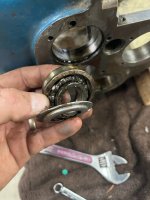How to install the app on iOS
Follow along with the video below to see how to install our site as a web app on your home screen.
Note: This feature may not be available in some browsers.
You are using an out of date browser. It may not display this or other websites correctly.
You should upgrade or use an alternative browser.
You should upgrade or use an alternative browser.
Need help with my new 10EE
- Thread starter grounding
- Start date
- Replies 345
- Views 22,294
I found some import replacements and I ordered them..... taking a gamble
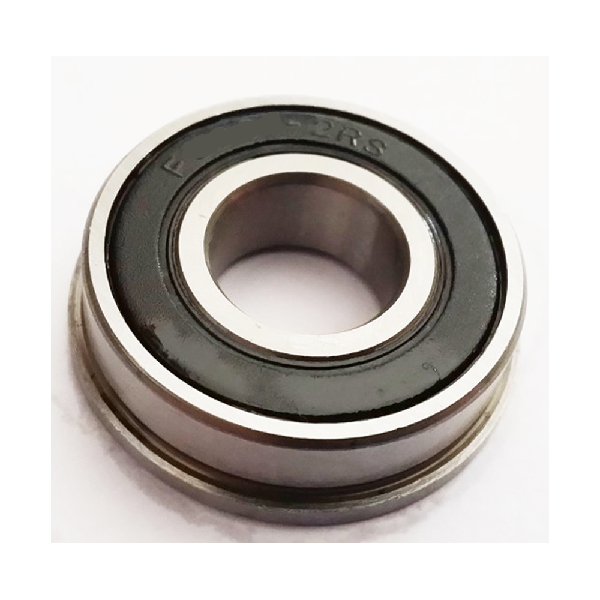
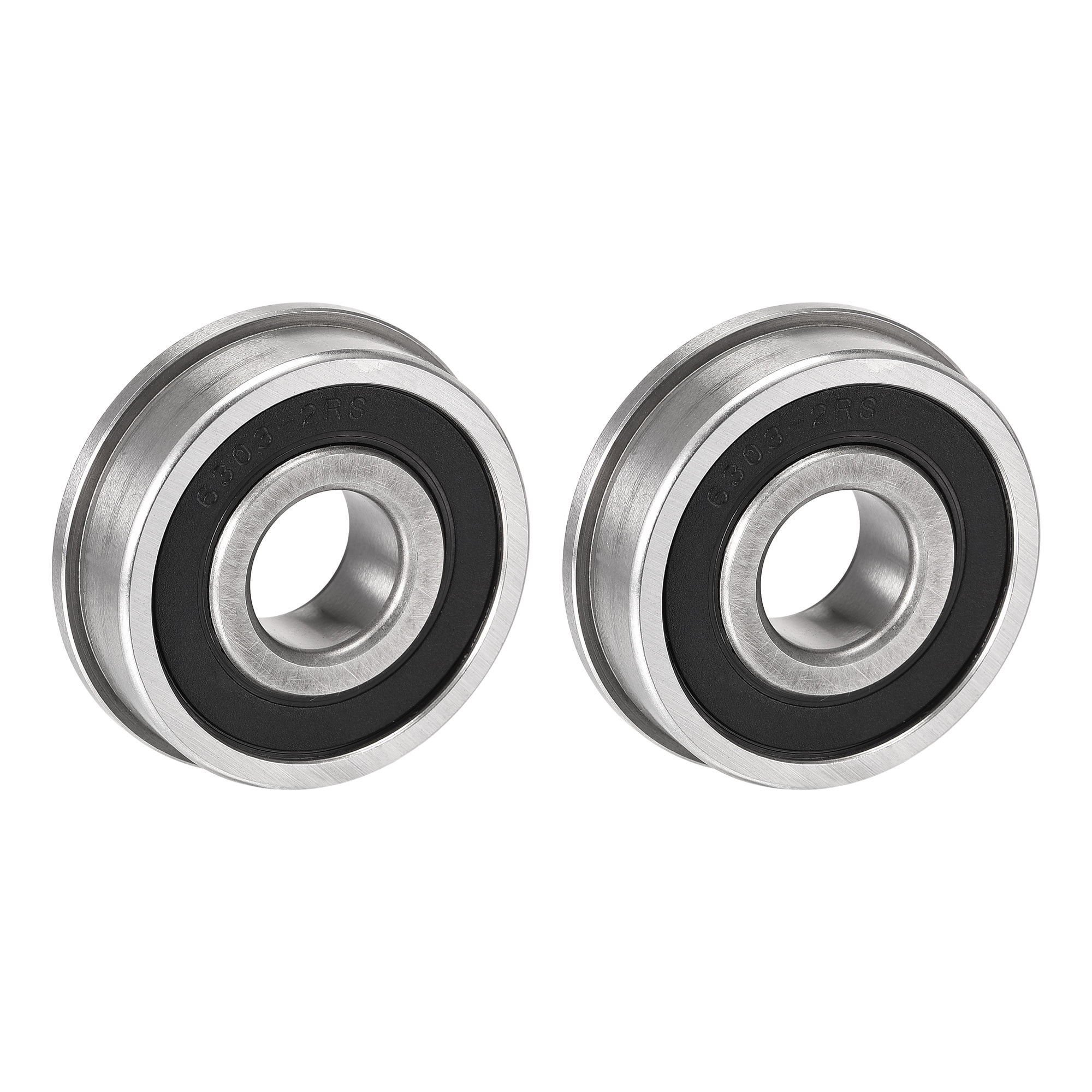
F6205-2RS Flanged Sealed Miniature Bearing 25x52x15 - Walmart.com
Arrives by Wed, Nov 16 Buy F6205-2RS Flanged Sealed Miniature Bearing 25x52x15 at Walmart.com
www.walmart.com

F6303-2RS 17x47x14mm Double Sealed Chrome Steel Flanged Ball Bearings 2 Pack - Walmart.com
Arrives by Fri, Nov 25 Buy F6303-2RS 17x47x14mm Double Sealed Chrome Steel Flanged Ball Bearings 2 Pack at Walmart.com
www.walmart.com
Cal Haines
Diamond
- Joined
- Sep 19, 2002
- Location
- Tucson, AZ
Those are radial ball bearings, you need angular contact bearings for that shaft.
Cal Haines
Diamond
- Joined
- Sep 19, 2002
- Location
- Tucson, AZ
The manual doesn't give the angle. A quick review suggests that they had 3 series of angular-contact bearings: the 0L00 series, which are described as "extra light"; the 20,000 series (which is what the leadscrew shaft uses) are described as "designed to resist heavy combined radial and thrust loads"; and the 30,000 series, described as "designed for very heavy, single direction thrust loads and when so used with the loads not subject to reversal of direction". Eyeballing the diagrams in the manual: the 0L00 series angle is about 15 degrees, the 20,000 series about 25 degrees and the 30,000 about 35 degrees.Cal, do you know what angle the bearings are ? I would guess lower rather than higher but that is a complete guess. Dave
beckerkumm
Hot Rolled
- Joined
- Aug 5, 2014
- Location
- Wisconsin Rapids WI
That makes sense assuming I have a clue. 40 degrees seemed like a lot and even with a 25 degree angle, they should not be interchangeable with a radial bearing. Thanks for the info. Dave
Cal Haines
Diamond
- Joined
- Sep 19, 2002
- Location
- Tucson, AZ
A quick search on eBay turns up Delco H20303, QH20303 and UH20303 bearings. (New Departure was a division of General motors, as is Delco.) I have no idea what the H, QH and UH prefixes mean (the seller might know). One listing shows a picture of an H20303 bearing and it doesn't have a flange. Someone on this forum ground a snap-ring groove in a bearing, but I doubt it was for this application. Modifing a bearing to use a snap ring and modifying the counterbore in the casting, if necessary, is an option if all else fails.
rke[pler
Diamond
- Joined
- Feb 19, 2002
- Location
- Peralta, NM USA
They're not under any particular stress so most anything would work. I'd pick something easy to machine.
CarbideTip
Aluminum
- Joined
- Sep 21, 2016
- Location
- Woking, Surrey, UK.
If you get chance, a sketch & some pictures might help others here faced with the same dilemma.Guys, I'm going to machine hubs, that I will press new angular contact bearings in to. My question is, what material do you suggest I make the hubs out of? Think just some 4140 would be fine?
Yep, I'll take pictures and upload when I'm done.....If you get chance, a sketch & some pictures might help others here faced with the same dilemma.
bobinict22
Plastic
- Joined
- Nov 15, 2022
FYI:A quick search on eBay turns up Delco H20303, QH20303 and UH20303 bearings. (New Departure was a division of General motors, as is Delco.) I have no idea what the H, QH and UH prefixes mean (the seller might know). One listing shows a picture of an H20303 bearing and it doesn't have a flange. Someone on this forum ground a snap-ring groove in a bearing, but I doubt it was for this application. Modifing a bearing to use a snap ring and modifying the counterbore in the casting, if necessary, is an option if all else fails.
From the 19th ND Hand Book, 1948, page. 94 list prefixes for
single row angular contact bearings as:
H = 25 degree Contact Angle
Q = Non-metallic separator
V = Bronze separator
N = Integral Locating Flange on outer ring
From the 23rd Edition of the Hand Book, on pages 62, 63 and 71
Q = Non-metallic separator and V (page 71 only) V = Bronze Separator.
Hope that helps.
Last edited:
CarbideTip
Aluminum
- Joined
- Sep 21, 2016
- Location
- Woking, Surrey, UK.
FWIW the CVA version does not have a cover over the bearing on this end.
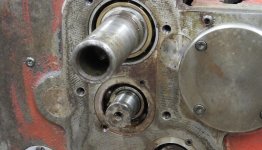
I did not take the bearings out on mine because of the potential difficulty in finding replacements, but I'm intrigued by the flanged bearing. I might just take my spare gearbox apart to see what CVA did here. Is it the general opinion that these odd bearings were made specially for Monarch?
In the UK my favorite bearing supplier has a range of A/C bearings with matching dimensions but without the flange.
Glad to hear that the cone shaft and tumbler gears arrived. Are they the same as the Monarch ones you removed?

I did not take the bearings out on mine because of the potential difficulty in finding replacements, but I'm intrigued by the flanged bearing. I might just take my spare gearbox apart to see what CVA did here. Is it the general opinion that these odd bearings were made specially for Monarch?
In the UK my favorite bearing supplier has a range of A/C bearings with matching dimensions but without the flange.
Glad to hear that the cone shaft and tumbler gears arrived. Are they the same as the Monarch ones you removed?
CarbideTip
Aluminum
- Joined
- Sep 21, 2016
- Location
- Woking, Surrey, UK.
Thanks MartinI think all the 10EE folks must be Christmas shopping!
On the CVA they are socket head cap screws. Monarch probably the same.
The casting has been spot-faced but it's not a deep counterbore. So it looks just like yours in this respect.
View attachment 380954
HTH.
Martin.
CarbideTip
Aluminum
- Joined
- Sep 21, 2016
- Location
- Woking, Surrey, UK.
My CVA was grey on the front and red on the back, but I could not remember where the color changed!
So it ended up all the same. Sorry that's probably not much help. Anyway pics:

All the insides and places where oil might accumulate were painted with an oil resistant paint. I should really have spent the money and got some Glyptal but the smallest can I could buy (US Quart IIRC) was large and and expensive. As far as I know it's only available in red and I would prefer a brighter color to make assembly a bit easier. Someone over here suggested a water based two pack epoxy which might have been OK if I had primed the cast iron first. I didn't and about 5 minutes after application it was covered in streaks of rust! Why didn't I think to prime it first?
The outsides were all painted after assembly and as its all brush painted I didn't need to mask as much as for spraying.
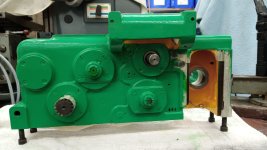

So it ended up all the same. Sorry that's probably not much help. Anyway pics:

All the insides and places where oil might accumulate were painted with an oil resistant paint. I should really have spent the money and got some Glyptal but the smallest can I could buy (US Quart IIRC) was large and and expensive. As far as I know it's only available in red and I would prefer a brighter color to make assembly a bit easier. Someone over here suggested a water based two pack epoxy which might have been OK if I had primed the cast iron first. I didn't and about 5 minutes after application it was covered in streaks of rust! Why didn't I think to prime it first?
The outsides were all painted after assembly and as its all brush painted I didn't need to mask as much as for spraying.


Similar threads
- Replies
- 19
- Views
- 1K
- Replies
- 13
- Views
- 765


